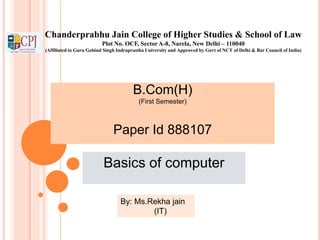
Introduction to IT
- 1. Chanderprabhu Jain College of Higher Studies & School of Law Plot No. OCF, Sector A-8, Narela, New Delhi – 110040 (Affiliated to Guru Gobind Singh Indraprastha University and Approved by Govt of NCT of Delhi & Bar Council of India) B.Com(H) (First Semester) Paper Id 888107 Basics of computer By: Ms.Rekha jain (IT)
- 2. CONTENTS Definition of computer Computers Have Two Main Parts What is Computer Hardware Examples of Computer Hardware More Computer Hardware What is Computer Software? Computer Input Devices Computer Output Devices General understanding of how your computer works Five Generations of Computers
- 3. DEFINITION OF COMPUTER A device that computes, especially a programmable electronic machine that performs high- speed mathematical or logical operations or that assembles, stores, correlates, or otherwise processes information.
- 4. COMPUTERS HAVE TWO MAIN PARTS Computer Hardware Computer Software
- 5. What is Computer Hardware? Computer Hardware is the physical part of the computer system, the machinery and equipment. Parts of the computer “you can see”
- 6. Examples of Computer Hardware Monitor: T.V. like screen used to show pictures and words. CPU: Central Processing Unit this is where most of the computer’s calculations take place. In terms of computing power, the CPU is the most important element of a computing system. Keyboard:This device is used to type information into the computer and contains the numbers 0-9.
- 7. More Computer Hardware Mouse: a small device, which you move across the top of the desk to move the pointer or cursor on the screen. Printer: used to make a paper copy of the information into the computer. Image Scanner: an electronic device that generates a digital representation of an image for data input to a computer.
- 8. What is Computer Software? • Computer Software are programs that tell the computer what to do. Examples • Microsoft Word-word processing program • Microsoft PowerPoint-presentation program • Microsoft Excel-work book program used to track, calculate, and analyze numeric data
- 9. Computer Input Devices • Computer Devices that input information in the computer Examples • Key Board • Mouse • Scanner • Digital Camera
- 10. Computer Output Devices • Computer Devices that output information from the computer. Examples • Monitor • Printer
- 14. Five Generations of Computers First Generation (1940-1956) Vacuum Tubes Second Generation (1956-1963) Transistors Third Generation (1964-1971) Integrated Circuits Fourth Generation (1971-Present) Microprocessors Fifth Generation (Present and Beyond) Artificial Intelligence
- 15. 1.First Generation (1940-1956) Vacuum Tubes The first computers used vacuum tubes for circuitry and magnetic drums for memory, and were often enormous, taking up entire rooms. They were very expensive to operate and in addition to using a great deal of electricity, the first computers generated a lot of heat, which was often the cause of malfunctions. First generation computers relied on machine language, the lowest-level programming language understood by computers, to perform operations, and they could only solve one problem at a time, and it could take days or weeks to set-up a new problem. Input was based on punched cards and paper tape, and output was displayed on printouts.
- 16. Second Generation (1956-1963) Transistors Transistors replace vacuum tubes and ushered in the second generation of computers. The transistor was invented in 1947 but did not see widespread use in computers until the late 1950s. The transistor was far superior to the vacuum tube, allowing computers to become smaller, faster, cheaper, more energy-efficient and more reliable than their first-generation predecessors. Though the transistor still generated a great deal of heat that subjected the computer to damage, it was a vast improvement over the vacuum tube. Second-generation computers still relied on punched cards for input and printouts for output.
- 17. Third Generation (1964-1971) Integrated Circuits The development of the integrated circuit was the hallmark of the third generation of computers. Transistors were miniaturized and placed on silicon chips, called semiconductors, which drastically increased the speed and efficiency of computers. Instead of punched cards and printouts, users interacted with third generation computers through keyboards and monitors and interfaced with an operating system, which allowed the device to run many different applications at one time with a central program that monitored the memory.
- 18. Fourth Generation (1971-Present) Microprocessors The microprocessor brought the fourth generation of computers, as thousands of integrated circuits were built onto a single silicon chip. What in the first generation filled an entire room could now fit in the palm of the hand. The Intel 4004 chip, developed in 1971, located all the components of the computer—from the central processing unit and memory to input/output controls—on a single chip. In 1981 IBM introduced its first computer for the home user, and in 1984 Apple introduced the Macintosh.
- 20. Fifth Generation (Present and Beyond) Artificial Intelligence Fifth generation computing devices, based on artificial intelligence, are still in development, though there are some applications, such as voice recognition, that are being used today. The use of parallel processing and superconductors is helping to make artificial intelligence a reality. Quantum computation and molecular and nanotechnology will radically change the face of computers in years to come. The goal of fifth-generation computing is to develop devices that respond to natural language input and are capable of learning and self-organization.
